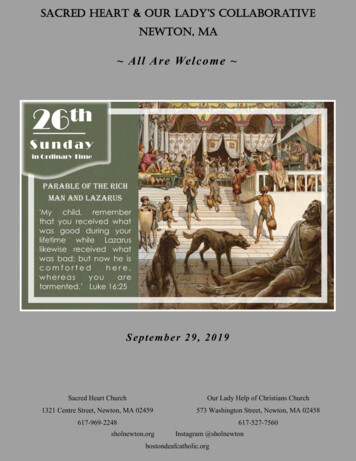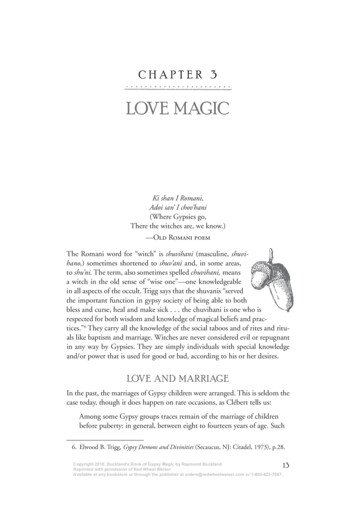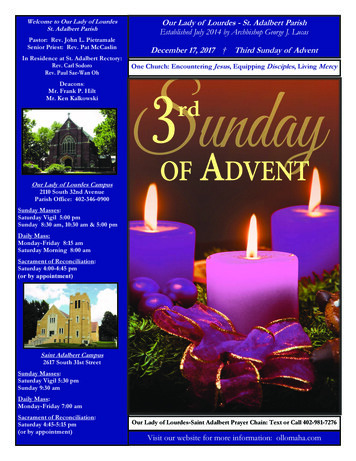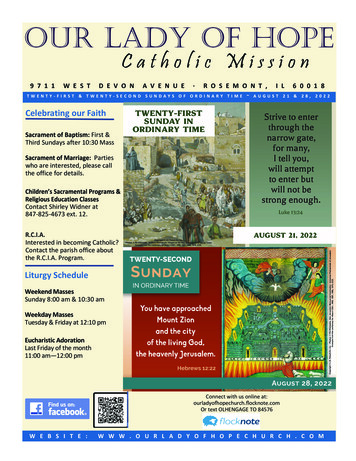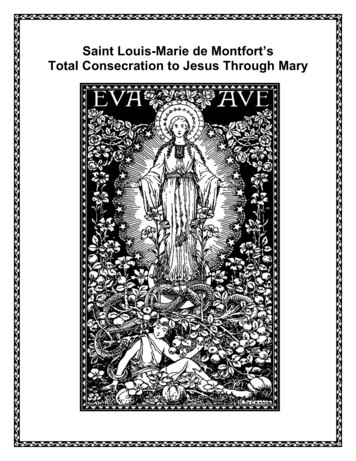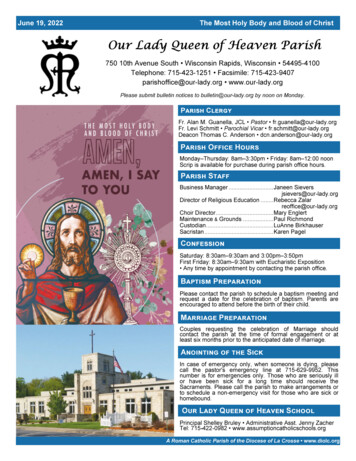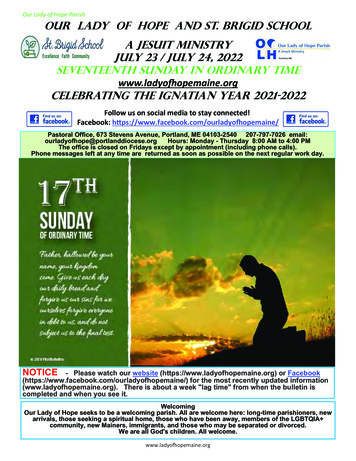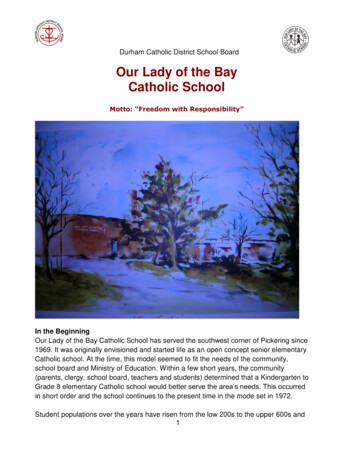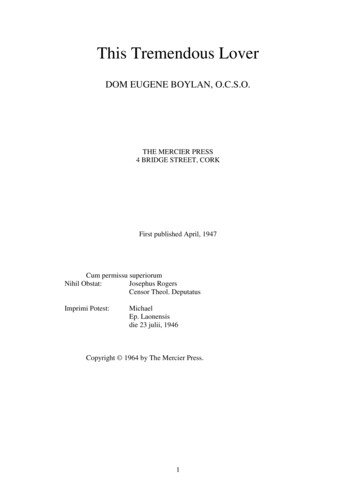
Transcription
This Tremendous LoverDOM EUGENE BOYLAN, O.C.S.O.THE MERCIER PRESS4 BRIDGE STREET, CORKFirst published April, 1947Cum permissu superiorumNihil Obstat:Josephus RogersCensor Theol. DeputatusImprimi Potest:MichaelEp. Laonensisdie 23 julii, 1946Copyright 1964 by The Mercier Press.1
to MaryTHE MOTHER OF THE WHOLE CHRISTAND THE WOMAN THOU GAVEST METO BE MY COMPANION2
PrefaceTHERE is a phenomenon in the natural order which illustrates a great principle of thesupernatural order: It is the structure and the growth of crystals. Each crystalline substancehas its own characteristic shape; wherever complete crystals occur, not only the wholecrystal, but also each unit of it, has that particular shape. If a crystal be suspended in asuitable solution of the substance of which it is composed—the “mother liquor” as it iscalled—that crystal will grow by drawing to itself material from the solution, forming it to itsown image and likeness, and then uniting it to itself, yet so that the new and greater unity isan exact replica of the original nucleus and of each of the component units.So it is with Christ. Lifted up on the cross, He draws all things to Himself; as St.Irenaeus says, “He recapitulated in Himself the long history of men, ‘summing us up’ andgiving us salvation, that we might receive again in Christ Jesus what we have lost in Adam,that is the image and likeness of God.”1On the cross, Christ “summed up” in one sacrificial act His whole life and His wholelove. In His life and death, He “sums up” the whole life and destiny of His Church, and alsothe whole life and death of each member of that Church. There is, of course, individualdiversity between the members but there is also a fundamental unity of pattern. To see it, onemust first look below the surface of the individuating differences to observe the commonpattern, and then stand back far enough from the complete unity to see it as a whole; forunless something of the consummation be glimpsed, there is difficulty in seeing the fullsignificance of the individual destiny and of the common bond.For the common bond—the bond of all perfection—is love, and the magnificence ofthe whole is the unity of love. The model according to which the whole is designed is theBlessed Trinity itself—“that they may be one as we also are one”.2 And the finalconsummation and achievement of the whole is summed up in one daring pregnant phrase ofSt. Augustine: “And there shall be one Christ loving Himself.” For “no one can love theFather unless he love the Son and he who loves the Son . . . loves also the members of theSon. And by loving he too becomes a member; through love he enters into the unity of theBody of Christ—and there shall be one Christ loving Himself—for when the members loveone another, the body loves itself.”3This book is an attempt to outline that love story of God and man, which achieves itsconsummation in the unity of the whole Christ; and to show that the spiritual life is apartnership of love between God and man which can be summed up in one word: Christ.Instead of describing a mere union of companionship, we have attempted to use St. Paul’sconcept of an organic unity in one body—in one Christ. Because of the resemblance of thenucleus to the whole and to each constituent part, as implied in the illustration of crystalstructure, such a treatment may, at times, seem to lead to confusion, even to contradiction. Allthe more so, as our main object is not to write a theological exposition of the doctrine of theMystical Body, but to show how that doctrine can be used as a basis of the spiritual life, andto draw from it some ideals and principles that will serve to animate that life in the souls ofordinary Christians.After the manner of St. Paul, we speak sometimes of Christ as an individual who isthe Head, as distinct from the society of the individual members who form the Body; at othertimes, we speak of Christ as the whole Body composed of Head and members. We speak, too,1St. Irenaeus: Adv. Haer. iv, 38 and 2. Many of our quotations from the fathers are taken from Fr. Kelly'stranslation of that splendid work on the Mystical Body by Fr. Mersch, S.J. The English translation is publishedby Bruce under the title The Whole Christ.2John xvii, 22.3St. Augustine, Epist. ad Parthos., P.L. 35, 2055.3
of our being “in Christ” and also of Christ’s being “in us.” Yet a further difficulty arises whenwe consider the individual member already incorporated in Christ by baptism, in relation toChrist considered as an individual quite separate from him; for example, as He is in theBlessed Sacrament. Such confusion is inherent in any attempt to discuss and depict in twodimensions what is really a four-dimensional entity, defying as it does the limitations ofspace and time, and ranging from time to eternity and back again.To avoid adding to this confusion we have reluctantly limited to one chapter theconsideration of the part played by our Lady in the formation of the whole Christ in ourspiritual life. She really has an important—one could almost say essential—part in everychapter. So much so, that we hope with God’s grace to consider her part as the Mother of thewhole Christ elsewhere at greater length. If for the moment we return to the illustration of thecrystal growing in the mother liquor, we may notice that the substance to be added to thegrowing crystal must first be dissolved in the liquid surrounding the crystal. Here we have anillustration which, with limitations, can well be applied to our Lady. If Christ be the crystal,Mary is the mother liquor, at least insofar as all comes to us through her, and through her weall go to Christ. There is no more certain or more easy way of being united to Christ than by“dissolving” ourselves in Mary. But we must remember that all her power of “dissolving” usis due to her intimate union with Christ. Yet, the chemist who remembers the part played bythe solvent in promoting chemical action and union between two substances, cannot helpbeing reminded of Mary’s part in the process of uniting men with God. And the illustration of“solution” is even more obviously applicable to our entering into union with God. For,Behold, a virgin shall conceive, and bear a son, and his name shall he called Emmanuel—which being interpreted is ‘God with us.’4To foster the development of that union with God in the lives of the faithful is thepurpose of this book. Our aim is devotional rather than didactic. We believe that the properfoundation of devotion is dogma, and that the best way to lead Catholics to live their Catholiclife in its fullness is to try to make clear to them what a Catholic really is, and what the plansand the principles underlying Christianity are. Believing that most of the evils of the day arisefrom the neglect of metaphysics in the world of thought and from the neglect of the interiorlife in the practice of religion, we try to show how the interior life is the logical sequence ofthe nature of the Christian, who, as someone has said, is composed of “a body, a soul, and theHoly Ghost.”Since, however, we are writing for everybody—for the layman as well as the priestand the religious—to the end that each may put into practice what we preach, we have nohesitation in sacrificing the unity of exposition and the logical development of the idea, inorder to put some practical ideals before the reader; and we hope, by discussing the practicesof the interior life, to indicate the practical possibility and the natural necessity of such a lifefor every Christian.The book resembles, somewhat, the general sketch of a building under construction,whereon details of special features are given at certain points which, at times, obscure themain drawing. The sketch is not the complete plan, and the notes of details are not workingdrawings. Exact working drawings of the various features of the construction must be soughtfor elsewhere, and the scientific exposition of the theology of the Mystical Body and of themystical life is already available from more competent pens.On one point we would like to sound a warning note. There is today a school ofpsychology which is said to interpret all vital striving in terms of one unique urge, whichthose who betray its originators, by translating imperfectly comprehended scientific termsinto popular catchwords, assume to be that intense sense appetite which man shares with the4Cf. Isaias vii, 14; Matt. i, 23.4
brute animal and which is all that our materialistic philosophy can find to correspond to theconcept of love. All else is interpreted by these second-hand dealers in popular psychology asa “sublimated” form of that lower instinct.Apart from the possibility that this doctrine may itself be the fruit of a deep-seatedneurosis originating in the racial and academic difficulties of its inventors, it would be fatal aswell as foolish to read such an interpretation into the scheme of this book. It would befoolish; for in the first place, the love of man for God presupposes a new nature, a sharing ofthe divine nature, an elevation of the whole being of man to a new order by grace. This lovefurther supposes what is almost a new faculty, or, to be more exact, the infusion of asupernatural virtue, by which the human will is enabled to perform a superhuman act. Therecan be no question of the “sublimation” of any natural appetite here. Further, even in thenatural order, there is a sharp distinction between the two natural appetites of man; betweenhis intellectual appetite, which is called the will, and his sense appetite, which is referred toabove. The will is a voluntary and a free faculty; the sense appetite is automatic and isdetermined by its nature.An error of this sort would be fatal, for it would blind one to the true significance ofthe mutual connection and the resemblance that can be traced in all the different works ofnature. So far from being evolutions or sublimations from below, they are rather reflectionsand images from above, more or less faintly showing forth in prismatic fashion the wondersof the Creator who designed them all; and it is quite a lawful proceeding to use the naturalorder as a means of knowing and finding the higher good—which alone is fully real.It would also be a grievous error to conceive the love of God as anything whichessentially involves sense-emotion or feeling. The love of God lies in the grace-aided will; itpresupposes the intellect insofar as the will needs its cooperation to love, for the will is ablind faculty; but in practice one need only attend to the will. A very high degree of love ofGod is quite compatible with an absence of any feeling of emotion, and even with thepresence of a feeling of distaste for the service of God. We have only to remember our Lord’sprayer in the Agony at Gethsemani to realize that. In fact, if one is going to achieve theheights of the spiritual life, it is necessary to pass through a stage where one’s apparentspiritual activity is reduced to a dry act of willingness to conform one’s self to God’s Will, inthe darkness of a sheer decision to believe in God without light of any sort. This does notmean that the emotions have not their part to play in the spiritual life. On the contrary, theycan be a most effective aid to the real agent, which is the will working by faith.There is, however, one conclusion that follows from our principles which seems to bein full agreement with the prescriptions of modern psychology. This science finds, as we do,that the source of much mental trouble and anguish lies in one’s incomplete adaptation toreality. Our discussion, starting from the principle of our incorporation in Christ and ourvocation to everlasting union with Him in heaven, leads to a practical program of humility,charity, and abandonment to the will of God. By humility, one accepts oneself with all one’sdeficiencies; by charity, one “adjusts” oneself to other members of society and lives for themas well as for oneself; by abandonment, one strives to fulfil one’s allotted task, and to acceptwillingly all that Providence allows to happen in one’s life. This is in full agreement withmodern scientific conclusions; our view has the further advantage of giving a sanction to, anda perfect reason for, such a loving acceptance of reality, and of explaining it in its truecontext and purpose.If, in the course of this book, the summit of divine love is proposed to everybody, itneed occasion no surprise. Such a height must be reached either here or hereafter. There is nochoice finally except heaven or hell. Heaven supposes perfect love of God which must eitherbe reached in this life, or else, with far more suffering, in the next life through the fires ofpurgatory. The easier way is to be sanctified here and now.5
Given that view, the fact that apparently we do not make extensive demands on thereader in the way of spiritual exercises may occasion further surprise. What we regard asessential is that the soul should put itself in daily contact with our Lord; and what we suggestin this book is an outline of the way to achieve that end and to make that daily contact afruitful one. If that much is done, we feel that the rest can be safely left to the guidance of ourLord. In any case, abandonment to the divine will and complete humility form no smallprogram. It should be noted that we use the word abandonment in an active as well as in apassive sense, to imply not only a generous acceptance of all that the divine will allows tohappen to us, but also a prompt and generous performance of all that the divine will clearlyasks of us. What we would emphasize is that it is the will of God which gives its value towhat we do. For love is the conformity of our will to the will of God, and love eventually isall that matters.In this book we have considered the importance of the interior life for the individualChristian. That it is also important for the Catholic body as a whole is just as certain. Theonly hope for civilization in its present crisis is that Catholics succeed in leavening society.Their success in doing so depends primarily not on their organization but on their interior lifeand personal love of God. Once Catholic Action puts the emphasis on the “Action,” andforgets the real meaning of “Catholic”—which in its essence is the result of union withChrist—then the failure of Catholic Action has begun. And if we Catholics have not had theinfluence on society that our numbers and our harmony with the essential principles ofChristian civilization should have produced, the reason is to be found in our lack of theinterior life. All Catholicity—individual, social, secular, or regular—must begin and end ininterior union with Christ. For there is no other name under heaven given to men, wherebywe must be saved.5Happily there is a shortcut to that union with Christ for the individual and for society.For as Pius X taught: “They are miserable and unfortunate who under the pretext of honoringChrist neglect Mary, for they do not know that the Child cannot be found except with HisMother.” And the same Holy Father quotes the text of the Apocalypse:And a great sign appeared in heaven. A woman clothed with the sun and the moonunder her feet and on her head a crown of twelve stars. And being with child, she criedtravailing in birth and was in pain to be delivered.6and applies it to our Lady, who, though blessed in heaven, is still laboring in a mysteriousbirth. “Whose birth?” asks the Holy Father:Clearly ours, who are still detained in exile and have yet to be brought forth to the perfectcharity of God and eternal happiness.7The part played by our Lady in our sanctification is so important that it calls for abook itself. Here for the moment we have to be content to discuss the perfect love of God towhich she brings us forth in Christ, but that reserve must not be taken to indicate any failureto appreciate her importance.To her after her Son, is due any good in this book. That it is the result of the teachingand the example of those who live and have lived according to the Cistercian Rule, does notlessen our indebtedness to her. To her, then, we offer it as an attempt to cooperate with her in5Acts iv, 12.Apoc. xii, 1, 2.7Pius X, Ad diem illum, 1904.66
her maternal work of bringing forth the whole Christ. Nos cum prole pia benedicat VirgoMaria.December 8th, 1945Feast of the Immaculate Conception ofthe Virgin Mary,THE ABBEY OF MOUNT ST. JOSEPH,ROSCREA.7
IntroductionIT is beyond the power of any human mind to know or measure the depths of sorrow thatfilled the Heart of our Lord Jesus Christ. One thing, however, we do know: that His sorrowswere begotten of love; of love for His Father so offended by the sins of men and of love formen so helpless in their sins. The pain of this love is so intense that even in the moment ofHis greatest earthly triumph when He rides in royal state into the city of Jerusalem amidst theacclamation of the people, His wounded heart bursts forth in tears, and His sacred lips utterthat most tragic of all lamentations: “If thou hadst known, and that in this thy day, the thingsthat are to thy peace: but now they are hidden from thy eyes”; and He goes on to foretell thedestruction that was to come upon the city because thou hast not known the time of thyvisitation.8 His complaint is no new one. Twice we hear the utterance of this frustrated lovethat is breaking His Sacred Heart: Jerusalem, Jerusalem, that killest the prophets, and stonestthem that are sent to thee; how often would I have gathered thy children as the bird doth herbrood under her wings, and thou wouldest not!9 And it is not His own loss that touches Himso much as the loss which those who reject Him would suffer: “Behold, your house shall beleft to you desolate.”These are but instances of a sorrow that ran through His whole life. It is the sorrow ofa lover who knew that He, and He alone, could give real joy and happiness to the heart of Hisbeloved. It is the sorrow of a lover whose heart was on fire to give rather than to receive—whose ardent desire was that His beloved might have life and have it more abundantly. It isthe sorrow of a lover who came down from heaven and lived on earth and was to die in orderthat a share of His own divine joy might fill the heart of His beloved. He was the Way, theTruth, and the Life. He knew that but one thing was necessary, and it was to give His belovedthis one thing that He delivered Himself and emptied Himself, becoming, obedient untodeath, even to the death of the cross.10Throughout the whole of His life and death, one can trace the desire to convince us ofHis love for us and of our need of Him. And one should remember that His intention is notmerely directed to humanity in general. He loves us as individuals, and died for us asindividuals. Each of us can truly say with St. Paul: He loved me, and delivered Himself forme.11 If then our Lord thought it of such urgency for us to seek the kingdom of God which iswithin us, that He deliberately endured His terrible passion and death for each of us, we, onour part, must realize that for our own sake, as well as for His, it is of vital importance thatwe should endeavor to understand and to perform what He requires of us.That is the purpose of these pages—to show what our Lord’s plan for our happiness isand to indicate how we are to cooperate in its achievement. What is written in this book isaddressed to every Christian, especially to those who have come to feel the limitations set bytheir own human self, and who feel the need of something more than their own unaidedefforts can achieve. For this book is the story of a partnership—a partnership between Godand the human soul, which begins at baptism—a partnership which should, by the joint actionof both partners, lead to an ecstasy of perpetual union in heaven. To perform one’s own shareof the work, one must have knowledge. To live as a true Catholic one must have some idea ofwhat a Catholic really is; to seek the kingdom of God, one must know something about it; tofind Christ and live in union with Him, one must have the necessary knowledge, forknowledge must come before love. Knowledge, of course, is not enough; it must lead toaction, to that action that is summed up in the two great commandments of love: the love ofCf. Luke xix, 41-44.9Luke xiii, 34 and Matt. xxiii, 37.10Phil. ii, 7, 8.11Cf. Gal. ii, 20.8
God for His own sake, and the love of our neighbor in God. But we are rational beings, andthe service of God is a rational service. Too often do we find devotion based on meresentiment and emotion, or on a foolish sort of faith that by defying reason approachessuperstition. Moreover, God is supreme wisdom, and nowhere does His wisdom shine forthmore remarkably than in His plan for our Redemption.If then many pages of this book are given to an attempt to show the fundamental unityand connection of God’s plan, it is because the effort to grasp the fundamental principlesunderlying His work is well worthwhile. Once one has caught a glimpse of the meaning ofGod’s plan to restore all things in Christ, one has the key, not only to the whole history of theuniverse, but also to the history and destiny of one’s own soul. All the details of the spirituallife fall into their proper perspective, and the quest of perfection is seen to be both possibleand reasonable for every Christian.But the plan is a complex one. It ramifies from time into eternity and from eternityinto time. It involves both the natural and the supernatural, closely interwoven. It joins Edento Calvary, and connects Calvary with each moment of time. It involves realities that have noparallel in the natural order. One can only speak of it in metaphors, and yet the realitysignified is far more real than the symbols used for its signifying. It is, in truth, God’smasterpiece. But our happiness here below and our eternal joy in heaven depend on it, andtherefore, even if the plan be not an easy one to grasp, any trouble its comprehension mayinvolve is well worth while.The difficulty will be lessened if we note that this plan of God is of a piece. It has aunity of purpose and a unity of pattern which give an order to all its variety. As we said in thePreface, it resembles a crystal. The pattern of the whole is found in each of its parts, and infact the parts are only incorporated into the whole by being made conformable to the whole—who is Christ. For Christ is all and in all. The whole Christ—head and members—resemblesChrist the Head. Each member is an image of the Head, for each Christian is another Christ.And the bond between the members is like the bond that unites the whole; so much so that St.Paul does not hesitate to compare the union of two single members in marriage to the unionof the Head with the whole Body. In fact, there is something “sacramental” in all the units ofthe pattern, in the sense that each member, and each member’s story, in some way and insome degree, resembles and reflects the Head and the story of the Head—and even the wholeChrist and the story of the whole Christ. Each tiny chapter of the story re-echoes the end ofthe whole story so daringly summed up by St. Augustine: And there shall be one Christloving Himself. For Christ saves us and sanctifies us by making us part of Himself, so thatHis story is our story also.It is, in fact, a love story—the story of God’s love for man, and therefore our ownlove story. But the happy ending of the story depends on ourselves, and we must make sureof our part in it. Journeys end, they say, in lovers’ meetings; if so, life is, indeed, a journey,which ends not merely in the meeting of lovers, but in their eternal union. That eternal unionwhich is the end of all, is modelled on the eternal union that is the beginning of all, and so toget a proper grasp of God’s plan for us it is necessary to go back to the very beginning.9
ContentsPreface . . . . . . . . . . . . . . . . . . . . . . . . . . . . . . . . . . . . . . . . . .3Introduction . . . . . . . . . . . . . . . . . . . . . . . . . . . . . . . . . . . . . . .8l. The Beginning and the Fall . . . . . . . . . . . . . . . . . . . . . . . . . . . . . .2. The Plan of Restoration . . . . . . . . . . . . . . . . . . . . . . . . . . . . . . .3. The Redemption. . . . . . . . . . . . . . . . . . . . . . . . . . . . . . . . . . . .4. The Mystical Body of Christ . . . . . . . . . . . . . . . . . . . . . . . . . . . . .5. Partnership with Christ . . . . . . . . . . . . . . . . . . . . . . . . . . . . . . . .6. Membership of Christ . . . . . . . . . . . . . . . . . . . . . . . . . . . . . . . . .7. Seeking Christ through Humilityand Obedience . . . . . . . . . . . . . . . . . . . . . . . . . . . . . . . . . . .8. Seeking Christ in Prayer . . . . . . . . . . . . . . . . . . . . . . . . . . . . . . .9. Seeking Christ by Reading . . . . . . . . . . . . . . . . . . . . . . . . . . . . . .10. Conversation with Christ . . . . . . . . . . . . . . . . . . . . . . . . . . . . . .11. Christ in His Sacraments . . . . . . . . . . . . . . . . . . . . . . . . . . . . . .12. Christ, Our Food and Our Life . . . . . . . . . . . . . . . . . . . . . . . . . . .13. Christ, Our Sacrifice and Our Supplement . . . . . . . . . . . . . . . . . . . . .14. The Will of God as the Food of Christ . . . . . . . . . . . . . . . . . . . . . . .I5. Union with Christ through Abandonment . . . . . . . . . . . . . . . . . . . . . .16. Union with Christ in Our Neighbor . . . . . . . . . . . . . . . . . . . . . . . . .17. Union with Christ through Humility . . . . . . . . . . . . . . . . . . . . . . . .18. Christ's Life-Giving Cross. . . . . . . . . . . . . . . . . . . . . . . . . . . . . .19. Union with Christ in Prayer . . . . . . . . . . . . . . . . . . . . . . . . . . . . .20. Confidence in Christ. . . . . . . . . . . . . . . . . . . . . . . . . . . . . . . . .21. Marriage and Holiness. . . . . . . . . . . . . . . . . . . . . . . . . . . . . . . .22. Mary, the Mother of the Whole Christ . . . . . . . . . . . . . . . . . . . . . . .23. Christ, Our Tremendous Lover . . . . . . . . . . . . . . . . . . . . . . . . . . .24. One Christ Loving Himself . . . . . . . . . . . . . . . . . . . . . . . . . . . . .111620273441Et erit unus Christus seipsum amans.St. 79188196
CHAPTER 1The Beginning and the FallIN the beginning, St. John tells us, was the Word, and the Word was with God, andthe Word was God.12 All things began with God, who Himself has no beginning for Healways is. Our life is limited in its extent and still more limited in its possession, for it comesto us bit by bit, in succession and not all at once. We have to let go of one moment to takehold of the next; it is like beads passing through devout hands. God’s life is unlimited in anyway; He possesses the whole of it all at once. He is the supreme and self-existent being,infinite in every respect, infinitely happy and completely sufficient for Himself.We may not even think of Him as lonely, for in God there is a Trinity of Persons. Inhuman knowledge one can distinguish a mind knowing, an object known, and an idea thatrepresents in the mind the object known. There is, of course, a great difference between theidea and the object to which it corresponds. In divine knowledge we have the perfection ofknowledge. God knows Himself, and His knowledge is so perfect that it corresponds exactlyto the object known. The Idea, or the “Word” as St. John says, which God has of Himself isso perfect that it is God Himself, the Second Person of the Blessed Trinity. “And the Wordwas God.” There are not two Gods, but there are two Persons, the Knower and theKnowledge—the Father and the Son. And these two are one God. But in God there is Will aswell as Intellect, and God loves according to His Knowledge. And the mutual Love of theFather and the Son is so perfect, that that Love is also a Person—the Third Person of theBlessed Trinity, whom we call the Holy Ghost. And these three are one God.Ordinary language fails us when we come to speak of the life and happiness of thedivine Trinity, who share everything without dividing it. Each of the three is God, yet there isbut one God. Their loving union is so intimate that They have but one nature, one existence,one life; everything except what pertains to their distinct personalities is common to each. Inshort, the life of God is an ecstatic union of knowledge and love—complete and infinitehappiness. God has no need of anything more; His joy and happiness are such that nothingcould increase them. Yet, in His infinite goodness, He decided to share them with somebodyelse. And so, out of the nothingness that was not God, He created us. It is true, that God couldnot without contradiction act for a motive less than Himself; being infinite Truth, He cannotdeny His own supremacy. But, in planning all creation for His own glory, He decided toglorify Himself by making His creatures happy. And when His creatures revolted against Hisplan, He went further in beneficence and arranged to find His glory in His mercy. And that isa fundamental principle that must never be forgotten: God made the world for His own glory;but He glorifies Himself in this life by His mercy.Of His creation of the angelic spirits and of the material universe, there is no need totreat at the moment. The angels were pure spirits, independent of matter, having the essentialpowers of knowing and loving, for these belong to all rational beings. The material universewas first created without life of any sort; then, came the lowest form of life which we callplant life, consisting of beings with the power of growth and of reproduction. The nextaddition was the animal creation, made up of beings which had the power of sensation andwhat is called sense-appetite, in addition to the powers found in plants. Finally God createdman, as a single individual who was to be the head of the human rac
my. There is . .
